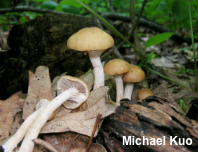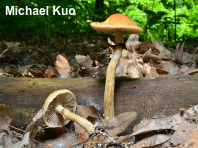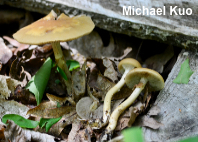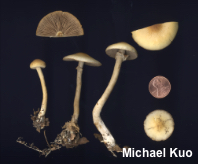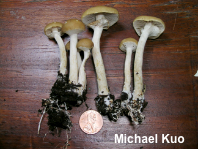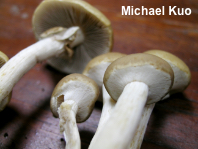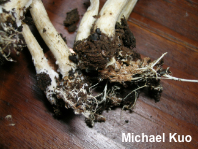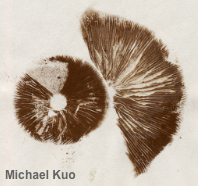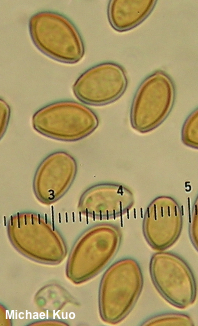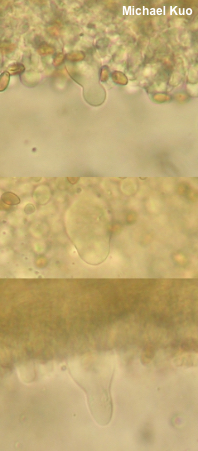| Major Groups > Gilled Mushrooms > Dark-Spored > Agrocybe & Cyclocybe > Agrocybe acericola |

|
Agrocybe acericola [ Basidiomycota > Agaricales > Strophariaceae > Agrocybe . . . ] by Michael Kuo The easiest way to separate Agrocybe acericola from other species of Agrocybe is with its ecology: it appears in hardwood forests from the Great plains eastward, especially in late spring and early summer. Similar species of Agrocybe grow elsewhere: Agrocybe biological species II appears in riparian ecosystems from the Rocky Mountains westward; Agrocybe praecox appears primarily in urban settings, in woodchips and compost, while Agrocybe dura appears in grassy areas (lawns, ditches, and so on). But, Michael, what about a woodchip path through a hardwood forest? What about a lawn that abuts a hardwood forest? Yeah, okay. My method isn't failsafe. However, there are physical features that also distinguish Agrocybe acericola, including its brownish yellow color, and the distinctive white ring on its stem, which is positioned very high and initially flares upward and outward (later it droops and develops a brown upper edge). Agrocybe acericola corresponds to biological species "III" in Flynn & Miller (1990). Description: Ecology: Saprobic; growing alone, scattered, or gregariously from or near woody debris in lowland hardwood forests; usually appearing in spring and early summer, but also appearing through fall; originally described from New York; widely distributed in the midwestern and eastern United States. The illustrated and described collections are from Illinois. Cap: 1.5–5 cm; convex at first, becoming broadly convex or broadly bell-shaped; sticky when fresh, but soon dry; bald; at first yellow-brown overall, becoming dull brownish yellow with a yellow-brown center; sometimes becoming radially wrinkled, especially near the center; the margin even, and not becoming lined. Gills: Narrowly to broadly attached to the stem; close; short-gills frequent; whitish at first, becoming dull grayish brown; at first covered by a white partial veil. Stem: 4–10 cm long and 4–9 mm thick; more or less equal above a slight underground bulb; bald; whitish to pale brownish; often twisted; with a high, thin, flaring, white ring that develops a brown upper edge; basal mycelium white; base attached to white rhizomorphs. Flesh: White; unchanging when sliced. Odor and Taste: Mealy. Chemical Reactions: KOH on cap surface negative. Spore Print: Brown. Microscopic Features: Spores 7–10.5 x 4–6.5 µm; more or less ellipsoid, with one end flattened for a 1–2 µm pore; smooth; thick-walled; brownish golden in KOH; brown in Melzer's. Basidia 25–30 x 7–8 µm; subclavate; 4-sterigmate. Cheilocystidia 35–45 x 10–15 µm; subutriform to utriform or clavate; smooth; thin-walled; hyaline in KOH. Pleurocystidia 30–65 x 15–25 µm; widely utriform, often with a long neck; smooth; thin-walled; hyaline in KOH. Pileipellis hymeniform; terminal elements 7.5–15 µm wide; clavate to pyriform; hyaline in KOH. REFERENCES: (Peck, 1873) Singer, 1950. (Singer, 1978; Smith, Smith & Weber, 1979; Flynn & Miller, 1990; Phillips, 1991/2005; Lincoff, 1992; Barron, 1999; McNeil, 2006.) Herb. Kuo 05260307, 05220401, 05290402, 05050602, 05291303, 07091607, 05161801. This site contains no information about the edibility or toxicity of mushrooms. |
© MushroomExpert.Com |
|
Cite this page as: Kuo, M. (2021, February). Agrocybe acericola. Retrieved from the MushroomExpert.Com Web site: http://www.mushroomexpert.com/agrocybe_acericola.html |
